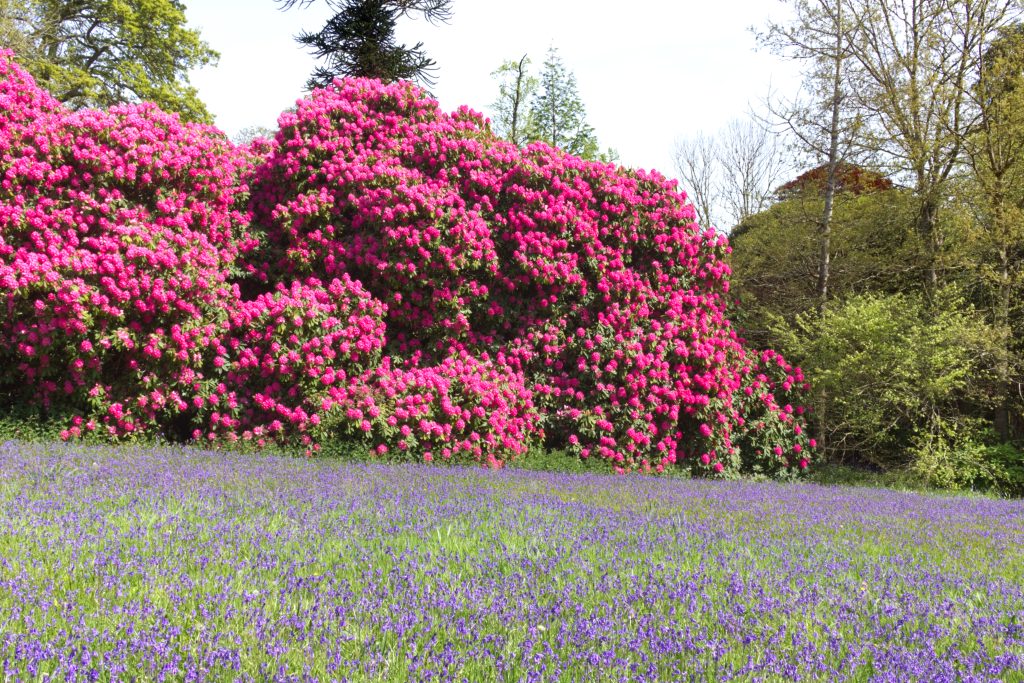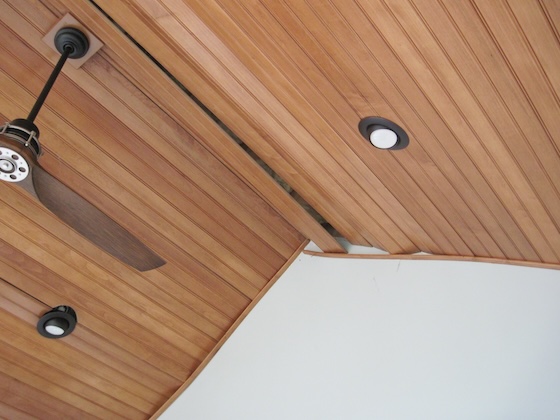

I’m terrible at garden visiting.
I always mean to get out and see other gardens, yet by the weekend I tend to lack the enthusiasm to go far from home. In my defence I do see gardens all through my working week….
A recent trip to a garden in Cornwall, in the south west of the UK, was just the tonic I needed. Sure I see great plants every day, and sure the fundamental elements that go together to make a garden are found everywhere, but there is still nuance and artistry to be discovered.
In search of inspiration
Cornwall is a county with a long gardening history; it’s an area with a usually mild climate, with short winters and early springs. Magnolias, Camellias and Rhododendrons grow well here, and in the county’s venerable old gardens these grow to enormous proportions. I made the journey not to see these giants however, but a plant much lower to the ground.

Big old Rhododendrons aren’t uncommon in Cornish gardens
The English ‘bluebell’, Hyacinthoides non-scripta, is a treasured plant, and with 25-50% of the population of this species occurring in the UK it’s easy to see why it’s a bit of a favourite. Outside the UK you will find this species right through the western nations of Europe; unfortunately it’s become a bit of a nuisance in parts of the US but I ask you to bear in mind that I was travelling to see this plant in what is definitely a ‘proper place’ for it.

To see a plant, even a native, growing where it should be is a joy
The country estate at Enys in Cornwall is renowned for its bluebells. At the cusp of May each year vast areas of the garden are carpeted in electric-blue flowers. The species itself tends not to vary much in height and colour (although pinks and whites can occur spontaneously), so in terms of the plant itself it’s very much a case of ‘seen one, seen ’em all’.

A place to rest and take in the scene
Yet as a mass these plants are so beautiful. I can’t even hazard a guess as to how many of these little stems there are through the gardens, but at the very least it will be a number in the hundreds of thousands.
Stewardship
Good stewardship of gardens requires great discipline. The small but dedicated gardening team are certainly equipped with an understanding of the importance of protecting what they have, yet for the bluebells to have reached the extraordinary numbers we see today means that generations of gardeners have also protected them. It takes one wrong decision to ruin the perfect carpet of blue, or one person to decide they want to sacrifice the annual spectacle for something else.

Bluebells with a stripe of white ‘bear’s garlic’, Allium ursinum, also native to this area
How the serene beauty of this scene would be ruined if someone decided to ‘improve’ it with some flowering trees for a bit more ‘interest’.
The bluebells are pretty much a motif of the garden, but there’s lots more at Enys to be enjoyed by the discerning garden visitor.
There are venerable trees and shrubs to admire, modern borders with herbaceous plantings, a stumpery, and even a large pond. It’s the ‘full package’, yet I’m going to skip over all of these things.
Ethos
The thing that makes Enys an important part of the UK’s gardening scene isn’t its features, it’s its ethos.

A rustic bench within a sea of flowers
This is an old garden with a long history, yet it’s a garden that lives in the ‘here and now’. To find a garden that respects its past, embraces its future and yet is firmly rooted in the present is always quite refreshing. All too often these big old estates become obsessed with trying to cling to the past, or conversely embrace modernity in a destructive way.
Gardens cannot avoid the future and it’s right to honour their past, but there is a balance to be struck. Enys has struck that balance.

A distinctly modern planting on a sunny bank, with the historic garden behind
The remnants of the old garden blend seamlessly with the newer elements, and the garden is at peace with its environment so there is little interest in battling nature. That said the garden does defend itself; many wildflowers are embraced but those that seek to conquer are removed without question. This is a garden, not a wild environment.
The Head Gardener, Danni Dixon, has found her space: her eye for beauty has undoubtedly been crucial for the protection of the many elements that gives Enys its identity, while also guiding the development of that special identity for future generations. It’s a credit to the owners of Enys that they see this gift and allow it to blossom; not everyone would.
Gardening, you see, is a craft. It’s a blend of artscience and technique; too often we gardeners get so absorbed by the technical and scientific side of gardening that we forget all about the art.
Gazing Upon A Blue Sea originally appeared on GardenRant on May 8, 2023.
The post Gazing Upon A Blue Sea appeared first on GardenRant.





More Stories
Why Should We Think About Our Winter Gardens Right Now?
5 Reasons You Need Snow Removal Services
Green Industry Veteran Nick Jiannas Joins Kress Commercial